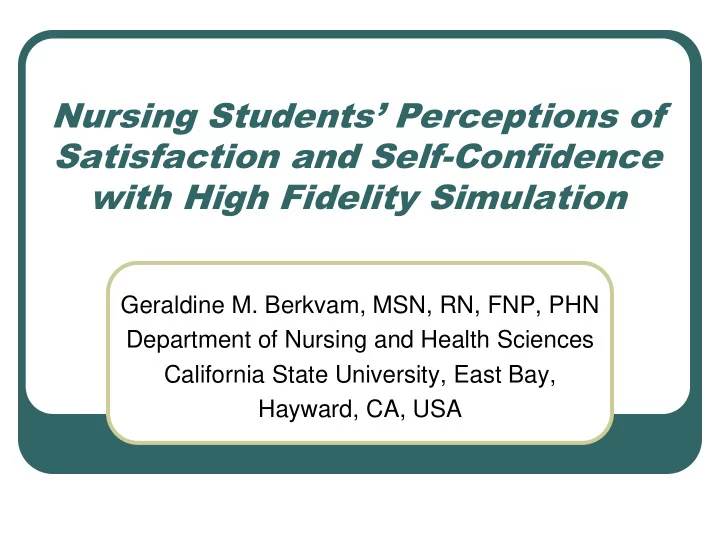

Nursing Students’ Perceptions of Satisfaction and Self-Confidence with High Fidelity Simulation Geraldine M. Berkvam, MSN, RN, FNP, PHN Department of Nursing and Health Sciences California State University, East Bay, Hayward, CA, USA
Learning Objectives By the end of the presentation: • Participants will be able to quantify nursing students’ satisfaction and self-confidence in learning when high fidelity simulation is used as a teaching strategy
Introduction There are few quantitative studies about student satisfaction and self-confidence in learning when simulation is used as the teaching strategy. Learning outcomes may be affected by student satisfaction and self-confidence.
Purpose To determine if high fidelity simulation provides nursing students with learning experiences which promote satisfaction and self-confidence in preparation for their practice of clinical nursing
Question Are nursing students satisfied and self-confident with their learning after completing high fidelity clinical simulations in preparation for clinical nursing practice?
Framework Alfred Bandura’s Social Cognitive Learning Theory: learning is the interaction between the person’s • Behavior • Personal factors • Environmental factors
Method Voluntary cross-sectional study after completion of high fidelity clinical simulation session • Demographic form and questionnaire • Data analysis: Cronbach’s alpha Pearson’s r Descriptive statistics
Subjects Third year baccalaureate nursing students enrolled in a medical surgical nursing course
Demographic Profile Age Distribution Ethnicity Distribution African Amerian 30 to 34 Hispanic 5% 25 to 29 20% 10% 30% Multiracial 10% 40% Caucasian 25% 35% 35 or more 25% Asian 24 or less
Data Collection Instrument Student Satisfaction and Self-Confidence in Learning questionnaire • Two sections: Satisfaction with Current Learning Self-confidence in Learning • Responses quantitatively describe students’ attitudes or beliefs • Developed by National League of Nursing
Questionnaire Responses Key for scores: 1 = Strongly disagree 2 = Disagree 3 = Undecided 4 = Agree 5 = Strongly agree
Satisfaction with Learning Histogram of Satisfaction Scores 60 50 Percent of Sample 40 30 20 10 0 3 4 5 Satisfaction Score
Self-Confidence in Learning Histogram of Self-Confidence Scores 30 25 Percent of Sample 20 15 10 5 0 2 3 4 5 Self-Confidence Score
Scatter Plot of Pearson’s r Correlation Satisfaction and Self-Confidence 5 4 Self-Confidence Score 3 2 1 0 0 1 2 3 4 5 Satisfaction Score
Results Cronbach’s alpha: 0.89 for satisfaction, and 0.80 for self-confidence with learning Pearson’s r: 0.85 (95% CI .64 to .94, p < .001)
Results Variable N M SD Mdn Satisfaction 20 4.24 0.35 4.0 Self- 20 4.10 0.45 4.0 Confidence
Findings • Students are generally satisfied and self-confident with learning • There is a correlation between satisfaction and self-confidence with learning from high fidelity simulation
Limitations Related to • Student population • Lack of a way to measure variances linked to questionnaire responses • Mechanism to measure changes in student perceptions longitudinally • Validity of content for simulation session
Conclusion & Recommendations High fidelity clinical simulation • Nursing students are satisfied and self- confident with learning • An effective teaching strategy • Further research is needed with • Diverse student populations enrolled in different nursing courses • Longitudinal studies
Recommend
More recommend